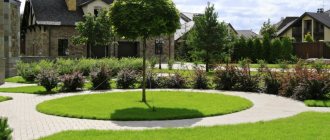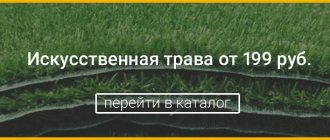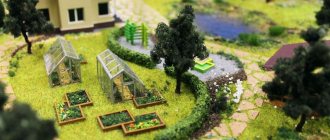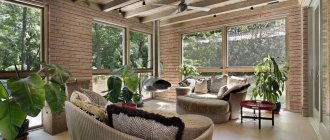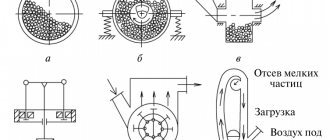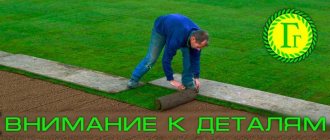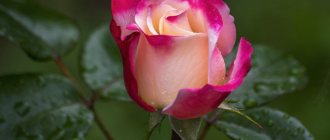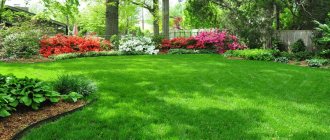Benefits of artificial turf
There are a number of advantages due to which artificial turf has become widespread:
- Artificial grass has a long service life.
- Even an inexperienced craftsman can easily carry out the work of laying grass.
- Ideal for decorating places with plenty of sunlight or, conversely, shady areas.
- The manufacturing technology provides for the creation of a durable coating that is resistant to mechanical stress.
- Large selection of shapes and textures. You can choose an artificial lawn to suit every taste at Leroy Merlin.
- The use of artificial turf in a garden plot eliminates the use of watering, mowing and maintenance systems. And this, in turn, eliminates unnecessary financial costs.
The presence of these advantages determines the wide popularity of synthetic canvas among landscape designers.

How durable is artificial grass?
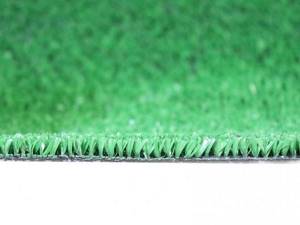
When assessing the durability of artificial grass, there are several things to consider:
- It tolerates various weather conditions much better than natural grass, incl. because the latest UV technology is used in its production.
- It is resistant to prolonged drought, and during heavy rains you can easily drain water accumulated on the lawn. So there are no problems such as puddles, mud or empty spaces scorched by the strong sun. High-quality artificial grass can withstand the winter without problems, and in the spring you do not need to use many treatments to return it to its proper condition.
- It doesn't matter where it is, be it in a poorly sunny location or perhaps in a location with poor soil conditions.
- Artificial grass is incomparably more resilient, so it can be used intensively for a very long time, while natural grass usually becomes damaged after about 300 hours of intensive use.
- It does not require mowing, fertilizing, watering, etc., which is a big relief even in terms of time and money. However, be sure to brush it and remove any accumulated leaves and other debris.
- Installation of artificial turf is not difficult, the main thing is that the surface is readable and level.
Disadvantages of artificial turf
Unfortunately, even synthetic fabric is not without its drawbacks:
- High price.
- Artificial turf easily heats up in direct sunlight, and in addition, heats the surrounding air.
- Once removed, the lawn cannot be recycled, which is not a plus from an environmental point of view.
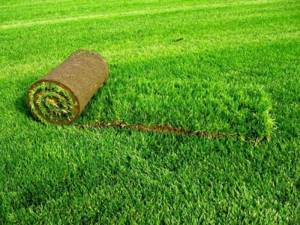
The fairly high cost of materials limits the too frequent replacement of the lawn.
Artificial grass – what are its advantages and disadvantages?
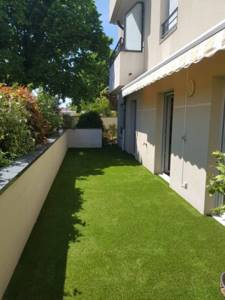
Advantages of artificial grass:
- looks natural and resembles a smooth, lush green lawn;
- resistant to weather conditions such as rain, frost and sunlight; does not fade or change color for many years;
- has good water permeability; does not get wet and does not form puddles, so it is perfect for swimming pools;
- easily accessible, you can buy it at any hardware store, as well as on the Internet;
- Grass comes in a wide range of patterns and colors - ranging from dark to light green, as well as other colors such as red, blue, black, etc.; You can also choose flat grasses with short pile or very soft ones with large and thick pile;
- it is easy to install - does not require special equipment or a qualified repair team, for example, when laying tiles or floors;
- this is a universal solution, because it is suitable for any balcony or terrace, as well as in any other place;
- easily adapts to any shape - it can be cut at will, so it will also be found in rooms of complex shape;
- it is easy to care for, it is environmentally friendly - it does not require watering or irrigation, it can be used many times;
- it is very pleasant to use - you can walk on it barefoot without experiencing discomfort;
- prices vary greatly, usually from 400 rubles / m2 to 5,800 rubles / m2, excluding installation materials; such a wide price range allows you to choose the appropriate option for our needs and capabilities;
- artificial grass, in principle, does not require any maintenance other than cleaning, for example, with a vacuum cleaner or rinsing with water; It is also worth regularly removing leaves and other waste;
- artificial grass is ideal for shaded areas with poor ground conditions, e.g. where natural grass simply won’t do;
- when using it, you can easily hide the poor condition of the floors, for example, old tiles on the balcony or terrace;
- made from child-friendly materials; Provides excellent shock absorption during falls and is resistant to intensive use;
- This is an economical solution; in addition to the initial costs associated with purchase and installation, it does not entail additional costs such as fertilization, watering, etc.
Types of artificial turf
Depending on the installation method and subsequent operation, all types of synthetic coatings are divided into three types:
- Infill lawn.
- Not a backfill model.
- Mixed coating option.
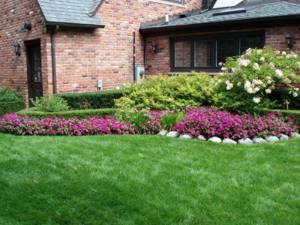
The choice of synthetic fabric depends on its main characteristics and the wishes of the owner of the site.

Artificial grass – which one to choose?
Artificial grass, if we choose the best quality grass, is not such a small expense, but in the future we will avoid additional costs associated with its maintenance and care.
In this case, very often the quality of artificial grass is adequate to its price.
If we choose a cheaper option, we need to take into account that it will not look as realistic as its slightly more expensive counterparts, the grass will be sparse and not as soft to the touch.
In addition, it can discolor much faster, for example due to sunlight. You should also remember that grass rolls come in different widths, most commonly ranging from 1m to 4m.
So think over the concept of developing the territory you are interested in so as not to pay for unused material.
You also need to consider the choice of color of artificial grass.
It turns out that in addition to the entire spectrum of shades of green, we can choose other colors.
It is true that there are red, black, blue, white, yellow or silver grass on the market, but on balconies, terraces and garden plots, the traditional option is certainly the best.
It is better to leave excess extravagance for finishing, for example, a children's room.
When choosing artificial grass for your outdoors, check how well it absorbs water and how quickly it dries.
Infill lawn
This type of coating is characterized by high strength and ability to hold its shape. The main material for production is polypropylene.
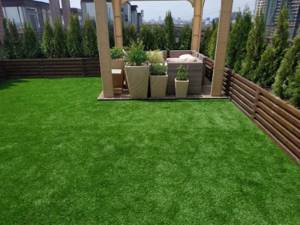
Most often, this coating is used for laying on large sports fields, children's playgrounds or for decorating recreation areas.
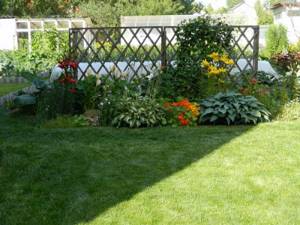
How to choose high-quality and beautiful artificial grass?
Artificial grass is an alternative option to natural vegetation. It can be placed anywhere; it can be used to decorate floors, furniture, interiors and recreation areas, as well as sports arenas. Synthetic lawn does not get trampled and remains attractive for a long time, and most importantly, safe.
Peculiarities
The first artificial turf was invented to decorate sports stadiums. After all, as you know, living grass, subjected to constant physical impact, is not able to maintain its original appearance, freshness and integrity. And often it is simply trampled down and you have to fill the resulting “bald spots” on the lawn. Previously, before the creation of synthetic vegetation, special, more resistant grass was grown, which, however, could not withstand all the hardships of sporting events. On top of everything else, it required special, expensive care, and growing it took a lot of effort and was extremely labor-intensive.
However, 50 years ago they found a solution to this problem in the form of nylon, the lawn of which was very similar to a carpet. Now the installation of rolls was not difficult and could be carried out in both indoor and outdoor arenas. And most importantly, in areas where real grass simply cannot survive. It is not surprising that landscape designers paid attention to this coating, because natural landscaping was not possible everywhere. For example, where children or pets constantly play, as well as in shady places.
Modern artificial grass is made from polyethylene and polypropylene. These are fairly stable types of plastic that can withstand heavy loads. It is worth considering that the structure of the lawn from different brands is not identical, although outwardly they are practically no different from each other.
As the popularity of synthetic turf grew, its scope of application expanded significantly:
- Decorating greenhouses and greenhouses: it turns out to be a kind of green path.
- As a finishing floor covering on terraces or balconies.
- Green area near the pools.
- Creating a safe play area near children's playgrounds or playgrounds.
- Decorating shop windows, summer areas in cafes and restaurants, as well as at various exhibitions.
- Finishing unsightly areas in a residential building.
Advantages
Since artificial grass was originally intended specifically for football fields, it has a number of undoubted technical advantages. It does not require special care and is resistant to dirt, soil and direct ultraviolet rays. Depending on the purpose for which the lawn was laid, it has the following positive qualities.
Design of children's playgrounds:
You can play all day without any time limit. A live lawn implies no more than two hours of games or sporting events according to the rules of operation. If the coating is installed correctly, moisture will not be retained in it. Changes in air temperature also do not affect the condition of the grass. In other words, the carpet is not affected by the weather or season. The springy layer plays a shock-absorbing function and reduces the load on the musculoskeletal system. It is less dangerous when falling on it and does not leave abrasions when sliding.
The surface is always even and smooth, as if the field was slightly moistened. This makes it possible to comfortably play active games and play sports.
When designing the territory of residential plots and landscape design:
The registration process takes very little time. To grow a good lawn, you need to sow the grass, apply fertilizers, water and perform other maintenance procedures. This requires both time and financial costs. Synthetics don't need all this. You can cover areas where plants have difficulty growing or do not survive at all. Also, in just a couple of days you can carry out any landscape project and “grow” a beautiful lawn. There is no need for regular lawn mowing, watering, etc. The material is absolutely safe for children and pets. It does not emit any harmful substances or odors and is easily cleaned with water. And finally, artificial turf is durable. It does not crush, retains its shape and color. Some manufacturers promise a maximum service life of 20 years without critical damage to the material.
Kinds
Artificial turf differs in design, method of operation and functional purpose. Therefore, when choosing it, it is necessary to take into account what purposes the coating will serve.
There are several types of coatings:
Unfilled . It is used as an exclusively decorative element for landscape design, as similar as possible to grass. If you actively walk on such a lawn, the blades of grass are crushed and sometimes pulled out, which ruins the aesthetic appearance of the surface.
Half-filled. This coating has a backing with plastic threads. During installation, they are covered with quartz sand. Thanks to the rubber base of the substrate, water does not accumulate in the coating. Most often used for finishing children's playgrounds, summer cottages, and for flooring in sports complexes or recreation areas.
Backfill . This type is intended for places with large crowds of people or football fields. This is because rubber crumbs and sand are located between the fibers, which reduce friction and extend the service life of the fabric. The fibers themselves are made of dense polypropylene. Lawn filler consists of foamed polymers.
Grass also varies in blade height and purpose. The lawn can be decorative or special. The first is used in landscape design, decorations and for camouflage. The special one is intended for sports arenas and playgrounds. For different sports it differs in the density of the canvas and the height of the grass.
Tips for choosing To make the right choice, follow these tips: You can purchase artificial grass on the Internet, directly from the manufacturer or in a specialized store. Both methods have their advantages. When purchasing a product in stores, you can see and touch the product. But to view the entire range, you will most likely have to visit several stores. The online store offers a wide range of products, but you can only look at them closely upon delivery. There is a risk of being deceived. Therefore, before making a purchase, you must familiarize yourself with the guarantee and refund methods. You should only buy lawn from trusted manufacturers and sellers; before doing so, you should look through customer reviews to avoid being scammed.
Modern technologies make it possible to create grass that is almost completely identical to natural vegetation. When choosing between foreign and domestic manufacturers, you should rely on certificates and customer reviews. Because both of them are not inferior to each other in the quality of manufactured products.
Before purchasing a lawn, be sure to look through all the models available in the range. You should definitely pay attention to what the carpet looks like and what it is made of. A lawn that is hard to the touch and shiny is most likely a cheap brand and is most suitable for decorative purposes.
We look at the height and thickness of the flooring. And also what kind of filler is used: sand or rubber granules. Long and fluffy pile is suitable for sealing any defects. But the longer the grass, the higher its cost. When making a purchase, you should ask the seller to show the quality certificate and issue a guarantee.
How to lay it?
The technology for installing a roll of artificial grass is not as simple as it might seem at first glance. In order for it to last a long time, the installation must be correct, especially if you decide to lay the canvas yourself. The main thing is to thoroughly prepare the surface on which the material will be attached. Before you start work, you need to accurately calculate the area and decide on the shape, and then transfer the results to the roll. In this way, a minimum number of seams and waste is achieved.
Let's prepare the base. There are several basic requirements for the base: No debris. Smooth surface. If this is soil, then it must be dense; we eliminate looseness. Thus, we begin the work by completely cleaning the area. We remove weeds and other unnecessary vegetation mechanically or chemically. It is important to remove all debris that could damage the integrity of the coating. If the base is earthen, then at the same time we level the surface, fill potholes, and fill the holes with soil. After all these manipulations, we compact the earth.
It is advisable to check the horizontalness of the base using a laser level. Optimal value: from 3 to 6 mm of slope per 1 linear meter. This value is especially important when laying the roll on concrete. If there is sand on the territory, it must be removed. Then compact the opened layer and place a drainage layer on it.
Removing excess moisture To protect the surface of the lawn from the accumulation of liquid, for example, during rain or snow, it is necessary to ensure its outflow. Liquid can drain and linger directly under the canvas. To avoid such an outcome, arrange drainage at a sufficient depth. A lawn base made of fine and medium gravel copes well with this task. Before laying a roll of grass, you should fill this area with water to identify areas of soil subsidence. If any are found, then soil should be added to this place.
Substrate Each base has its own substrate, consisting of a different number of layers.
Concrete base: Artificial turf. Geosynthetic material. Reinforced concrete. Crushed stone 20 and 40 mm. Geotextiles. Sand. Geotextiles. Pre-compacted soil layer.
Base made of crushed stone and sand: Artificial turf. Granite screening 1 and 5 mm. Crushed stone 5 and 20 mm. Geotextiles. Sand. Geotextiles. Pre-compacted soil layer. Crushed stone base: Synthetic turf. Rubber shock-absorbing backing. Fine granite screenings. Large crushed stone. Geotextiles. Pre-compacted soil layer.
These examples are given for professional decorative work or design of sports grounds. The number of layers may be reduced if the load on the lawn is light.
Installation of artificial grass Take a roll and unwind it in one direction. So that the villi are literally tilted to one side. We lay the canvas exactly end to end, but if the edges are crooked, then we overlap up to 10 cm. Let the material sit for one day so that it is completely straightened out and minor defects in the grass disappear.
It is necessary to cut the roll in the middle of the overlap with a stationery knife or scissors using a ruler and chalk. By pulling the edges of the two canvases, we check how tightly they fit together. The gap between them should not be more than 1 mm. After this, we connect the edges of the lawn cloths with a tension stitcher or connecting tape.
The instructions must indicate the connection method. Before fixing the lawn to the ground, add sand or rubber granules. This procedure is performed only for infill and sometimes semi-infill types of grass. After this, we fix the edges with garden staples, wire, strips or nails. Useful tips to make your work easier: It is better to apply two-component glue to the connecting tape using a notched spatula (3-5 mm). In this case, excess glue will not protrude on the canvas. During work, do not allow dust to settle on the belt, leaves and waste (clippings) to stick. You need to place a heavy object on the freshly joined edges to help them grip better. It is better to distribute sand and granules with a rake, broom or seeder. Proper installation is a guarantee that the artificial lawn will last a long time.
How to care? Proper installation is important, but proper maintenance of the coating is equally important. No special tools are needed here, and the process itself will take a little time:
Once every seven days you need to comb the lawn, a brush will help with this. This is necessary so that the filler is distributed evenly, and the pile remains fluffy and raised. In the autumn, it is necessary to remove fallen leaves daily with a lightweight rake so that the quality of the grass does not deteriorate.
Weeds rarely grow through the lawn, as textiles prevent it. However, sometimes it can get through between the tiles, through the covering itself, or closer to the wall. Therefore, the perimeter must be framed with a plinth. If weeds are still noticed, they must be removed. Sharp objects, chewing gum, and cigarette butts can significantly damage the integrity of the coating.
Do not walk on the surface in shoes contaminated with soil or natural grass. Shoes with spikes are also prohibited. On children's playgrounds or places where pets roam, the coating can be treated with special approved bactericidal substances.
Snow or ice should only be cleared with a broom or other safe tools. It is better to clean them when the air becomes warmer and the snow and ice melt, so as not to damage the pile. In hot and dry weather, the lawn must be moistened with water. At least once every six months you need to add fresh filler to avoid deformation of the structure.
Artificial turf does not require mowing.
Reviews Many buyers are concerned about the environmental friendliness of such products. However, at the moment there are models that can be recycled. You need to clarify this point when purchasing.
In general, buyers are satisfied with the quality of the coating. The money spent on purchase and installation pays off. There are often options when artificial grass is combined with live plants.
Due to its characteristics, artificial grass is widely used in various directions. It can be found especially often in such areas as landscape design.
Grass is also used to decorate: children's playgrounds, recreation areas (parks), football and sports grounds. Football fields. For a long time, natural grass on fields was the only option. However, caring for it was difficult, and during operation the coating inevitably became deformed. Therefore, the decision was made to replace natural grass with alternative synthetic fibers. This is how the first nylon lawn was created, which had excellent characteristics; it completely covered the ground, thereby isolating it. It was replaced by simpler and cheaper materials made from polyethylene. This plastic adapts well to the Russian climate and is characterized by a long service life and high wear resistance. The color of the coating can be mixed: green with a pink border or even white. You can literally place such a covering anywhere, but again the soil is isolated, which is why the earth lacks oxygen.
Interior. When decorating rooms and buildings, they use special carpet. It can have a variety of colors. This type of carpet fits perfectly into almost any interior and is unpretentious. The coating has a natural green color. Plastic grass can be used to decorate any problem areas and hide them from view or make a bright and unusual accent. You can also decorate some interior items with grass.
Country cottage area. When purchasing a lawn for a summer cottage, you need to focus not only on cost, but also on softness and elasticity. For example, material made of propylene. It can be used to easily decorate a staircase, but it is not recyclable. When choosing a color, it is better to opt for products with a matte and natural shade. They will last a very long time. Blades of grass are 7 mm high, roll length is 25 m, standard color is green. It can be laid as a decorative rug, but it is subject to strong heat.
Landscape design . Synthetic grass is a godsend for designers, because there is no need to take into account the specific terrain and soil type. In addition, such models can be of a variety of colors, which allows you to safely experiment with them. Pile height 20 cm, roll length 25 cm. Color can be pink, red or other. The advantages are bright and unusual colors and easy care. But the color fades quite quickly.
Finish floor covering. This carpet can imitate the structure of a natural lawn and helps create your own green corner or place for games (for example, golf) in your home. Pile height 5 mm, roll length 25 cm. Color natural, green. Safe for people with allergies and non-slip.
Plastic lawn is the creation of human hands. Despite some shortcomings, overall this is a great option for a wide variety of purposes. It also makes it possible to create unusual interior solutions that would be impossible with live grass.
Requirements when choosing a lawn
Choosing the right coating for your garden plot will significantly extend its service life and achieve the most effective decorative design.
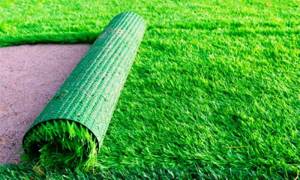
Requirements for synthetic fabric that determine the choice of coating:
- Density and height of the pile of the material. The denser the fibers are, the longer the lawn will last on the site.
- Laying method. The owner of a garden plot can choose one of the types of canvas at his discretion: rolled or tiled lawn.
- Hue and color saturation. This indicator plays only an aesthetic role, and the choice depends on the overall interior of the yard.
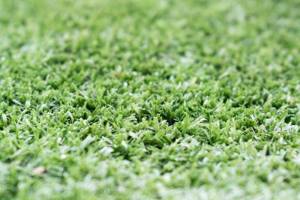
You can make the right choice with the help of consultants in a construction hypermarket, or by reading in advance photos of artificial turf in landscape design magazines.
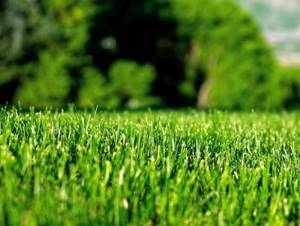
The best rolled lawns
This type of lawn includes grass that has been previously grown and rolled together with the turf layer into rolls. Typically, their width is 2-4 m and their length is 25 m, which significantly saves time and physical effort on installation. However, you will have to care for it in the same way as one grown from seeds: water, remove weeds, trim. Less demanding and at the same time quite effective are the 3-roll plants discussed below.
Classic
Rolled lawn "Classic" is made for those who want to quickly get a beautiful and functional grass surface for a sports field, country house or country house. It is also well suited for city parks and boulevards. This option is distinguished in the rating by its low maintenance requirements and the possibility of good growth both in shady conditions and in sunny areas.
The composition includes the best types of grass for a rolled lawn - meadow bluegrass and red fescue, which are equally distributed. This combination guarantees high density, interesting texture and good lawn resistance to various diseases. It is also characterized by low maintenance costs and undemandingness in terms of feeding. Due to its moderate growth, you won't have to trim it often.
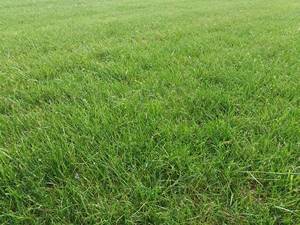
Advantages
- Adapted to changing weather conditions;
- Good density;
- A large roll – 0.4 x 2 m for an area of 0.8 sq. m;
- Easy to cut.
Flaws
- Average resistance to trampling.
Some buyers complain in reviews about the uneven color of the lawn. This can be explained by the content of narrow- and broad-leaved herbs in the mixture.
Picnic
Rolled grass “Picnic” stands out in the ranking because it is lighter in color compared to other bluegrass grasses and begins to turn green much earlier in the spring. It quickly forms strong turf and shows high resistance to trampling. A finished lawn can easily be achieved with average agricultural technology, which even beginners can provide.
The Picnic grass mixture can withstand long droughts and does not require frequent watering. However, because of this, the color of the coating will be less saturated. Low fertilizer costs make it quite profitable to maintain. These seeds are especially well suited for implementing landscape design on a summer cottage and in a country house.

Advantages
- Plain throughout;
- Smooth and pleasant to the touch;
- Easy to cut;
- Weed resistance;
- You don't have to remove the grass clippings.
Flaws
- Fast growth;
- Relatively wide leaf;
- Loves sunny areas.
“Picnic” is sold in standard rolls measuring 0.4 x 2 m for an area of 0. sq. m. m.
Standard
The “Standard” lawn consists exclusively of meadow bluegrass: Granite, Blue Velveeta, Langara, Starburst (25% each). The grass has good resistance to trampling, frost, and drought with minimal attention. It is adapted to growing in partial shade and open areas. As a result, a thick and even, uniform cover of an attractive rich green color grows. It is characterized by resistance to various diseases. This option is suitable for arranging green recreation areas in the city (parks, squares, embankments) and in suburban areas.
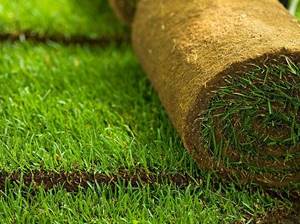
Advantages
- Not very tall, which means you won’t have to spend a lot of effort on cutting;
- Retains its bright green color even during droughts;
- High-quality turf surface;
- Displaces weeds;
- There is no need to wait 2-3 years to get thick grass;
- Easy to install.
Flaws
- It is not very convenient to cut hair by hand.
When trying to choose which lawn grass is best to plant for functional purposes, for example, for children to play with, it would not be a mistake to choose this option.
Synthetic turf materials
The material used in the manufacture of artificial turf determines its main characteristics in practical use. Today, all synthetic coatings are made from the following bases:
- Plastic.
- Polyethylene.
- Polypropylene.
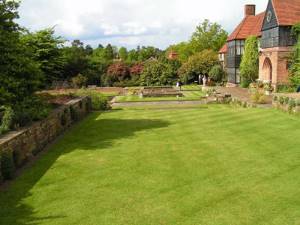
Each of the presented options has special requirements for care and installation.
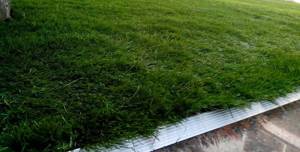
Polypropylene lawn
Special characteristics are strength and resistance to deformation.
The manufacturing technology provides for additional crystallization of the pile, due to which the material acquires additional resistance to rapid wiping in areas of maximum load. And to all the advantages is added the quality of decorative finishing.
Step-by-step lawn laying
The owner of the site can do all the work; you just need to stock up on the necessary materials, a set of tools and patience. The entire work process can be divided into the following stages:
- Site preparation.
- Laying the substrate.
- Direct laying of artificial turf.

For beginners and inexperienced craftsmen, there are ready-made installation and step-by-step installation schemes for synthetic coatings, with a detailed description of each stage.
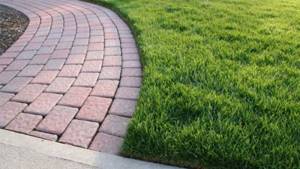
Site preparation
First of all, the selected area of land must be cleared of debris, dirt, splinters and small stones that can damage the coating. Next, it is advisable to mark the area using small pegs and rope. If it is difficult for a novice master to navigate, you can use a drawing diagram.
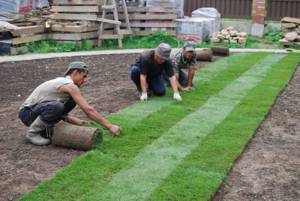
Next, you need to level out all the bumps and holes that are on the site. To do this, you can use a large log without knots or a metal pipe. Shallow drainage grooves are made along the edges of the future covering to drain rain and melt water.
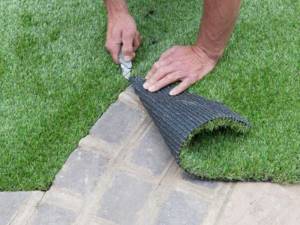
How to care for artificial grass?
There is no need to worry about the quality of artificial grass, although it is worth remembering to maintain it regularly.
It should be regularly cleaned of dirt and debris, for example with a vacuum cleaner in the case of home carpets.
Recommendations for the care of artificial turf should:
- Brush your grass regularly with a stiff brush (not wire bristles) to keep it in good condition and straighten the fibers. It is enough to carry out these events once every 3 months. Most often this is done only in commercial real estate.
- Remove debris such as leaves, weeds, etc. regularly.
- All vegetation (leaves, weeds) can be removed by hand using a soft-tipped rake or blower.
- Dirt and stains can be removed with a brush and a 3% ammonia solution, greasy stains with ethyl chloride, organic stains with warm water and vinegar or soap. You can use rags, mops, and soft brushes to clean the grass.
- Dust and dirt are easily washed off with water. Artificial grass should be washed from time to time, especially on hot days, but this is not as necessary as with natural lawns.
- For stubborn stains, such as oil stains, it is worth using professional grass cleaning services offered by specialized companies.
It is also not recommended to leave open fires, hot barbecues or fireworks on synthetic lawns.
You should also avoid placing furniture with sharp edges on artificial grass, which could damage the fibers or backing.
In turn, to avoid discoloration, do not use oxidizing or acidic agents, and do not expose the grass to sunlight through glass or metal objects.
Mechanical deicing or intensive use at temperatures below minus 15 degrees Celsius is not permitted.
Laying the substrate
A base is required if you plan to lay the lawn on a hard surface - concrete, old tiles, asphalt. Due to the special properties of the material, the underlying coating reduces friction between the lawn and the solid structure of concrete or asphalt.
Today there are a lot of types of substrate, and the choice depends on the type of synthetic lawn, the preferences of the owner of the site and his financial capabilities.

Laying lawn covering
Step-by-step instructions on how to lay artificial turf:
- Rolls or slabs (depending on the type of lawn covering chosen) are rolled out on a flat surface and left for 10-11 hours to smooth out all the unevenness and straighten the fibers.
- Before laying, the edges of each strip from the roll are trimmed with a very sharp knife. This is necessary so that the workpieces subsequently lie perfectly flat on the base or soil.
- Adhesive tape is laid between adjacent pieces to connect the lawn elements.
- After laying the entire area of the lawn, the surface is covered with quartz sand to increase its resistance to mechanical deformation.
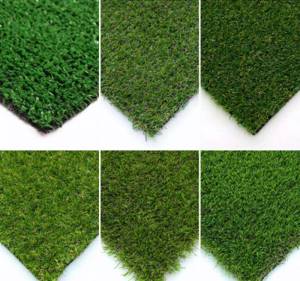
As you can see, laying artificial turf is quite easy.

Artificial grass - what is it?
Artificial grass is a synthetic product that has been developed using fleece to resemble grass stems.
Most often, polyethylene or polypropylene is used for its production, since they are highly resistant to mechanical factors.
The combination of polyethylene with polypropylene makes the artificial grass softer and at the same time it retains the appropriate performance properties. The green grass fibers are laid on a special backing so it can be installed like a regular carpet.
This grass can be successfully installed in both private places (eg balconies, terraces, backyards) and public places (eg outdoor gardens of restaurants or pubs).
When purchasing it, an important role is played by the appearance of the product, as well as its height.
For public places, artificial grass with a thickness of 7 to 15 mm is most often chosen. As a rule, artificial grass is placed on balconies and terraces, which most closely resembles natural grass.

In this case, the height varies between 15-40 mm.
When installing artificial grass in summer gardens or terraces, consideration should be given to water drainage – this is very important. Artificial grass intended for outdoor use has special holes (they are not visible from the top layer of grass) through which rainwater and water used to clean it are drained.
Of course, the big advantage of artificial grass is the ease of walking on it - you can walk barefoot and feel pleasure, almost like walking on natural grass.
There are different types and colors of artificial grass fibers available in stores, so everyone can choose something suitable for their needs, such as the likeness of natural spring grass or forest clearings.
